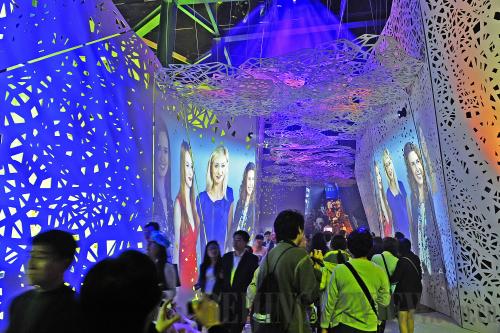|
 |
|
EXPERIENCING POLAND: Visitors walk down a hall decorated with digital screens in the Poland Pavilion at the World Expo in Shanghai on May 1 (GUO CHANGYAO) |
Unlike many pavilions shining with the very latest technological wonders, the Poland Pavilion stands out for its cultural charm.
From dawn to dusk, long queues of visitors wait patiently to catch a glimpse of the mystery of the distant central European country, with neither chilly drizzle nor blazing sun affecting their enthusiasm. And despite the continental distance between Poland and China, with the first steps into the pavilion Expo visitors will see just how much the two countries have in common.
The 3,000-square-meter pavilion, mainly made of wood, gives the impression of a huge folded box of paper cutouts, a folk tradition of Poland and China. During the day, sunlight can enter the main exhibition hall through cracks in the walls. In the evening, the pavilion shines from within, changing colors to light up the dark sky and making it seem as if the cutout figures are dancing on the walls.
The cutouts are used as Christmas and Easter decorations in rural areas. Polish craftsmen can cut out an intricate pattern continuously, without clipping any piece of paper midway, Anna Rudawska, Press Officer at the Bureau of the Commissioner General of the Polish Section of Expo 2010, told Beijing Review.
Most construction materials for the pavilion are recyclable, and after the Expo concludes in late October, part of the wooden structure will be reconstructed in a Polish city. "The pavilion design evokes ancient artistry, abstract design and futuristic thinking," said Slawomir Majman, Commissioner General of the Polish Section of Expo 2010.
"We just want to show the world that one can lead a good and comfortable life in Polish cities, combining a respect for the past and tradition with the challenges of the present and the future," he said.
Past and present
Wandering through the pavilion, imprints of Polish history are everywhere. The solid inner walls are installed with digital screens telling vivid stories about how the country went through two world wars, the industrial revolution, as well as the latest financial storm.
Despite the lasting traumas, the Poles have never given up the joys of life and the hope for a better tomorrow, said Majman. "That is how we understand the motto of the pavilion—Poland is Smiling."
Indeed, barely a corner of the pavilion is left out of the joyous mood. A curved path leads visitors through the four seasons in a rural Polish landscape where the spring and summer blossom with vitality and intense colors, while autumn and winter offer snowy serenity. With the splendid mountains and calm deep lakes in sight, visitors feel as if they have left the hustle and bustle of the city behind.
The stirring sounds of music from beloved Polish pianist and composer Frederic Chopin reverberate through the air, touching the hearts and minds of listeners. When dusk falls, the pavilion becomes a dazzling dance floor where passion and energy never recedes. Boys and girls, and men and women indulge themselves in the party, shaking and bouncing to rhythms of classic Polish folk music.
Culturally connected
It's more than just the paper cutouts that make the Chinese feel more at home in the Polish Pavilion. An animated dragon, projected on the interior wall, swings and draws constant laughter and cheers from the crowds.
| 